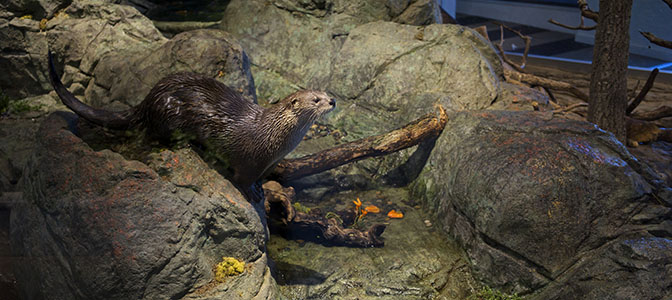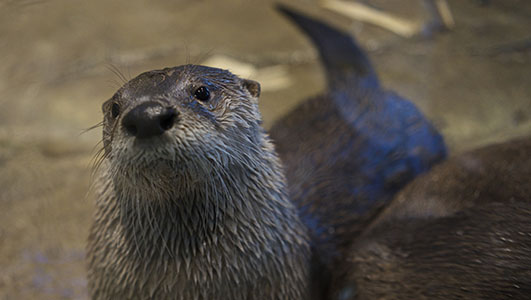Extending from the smallest seasonal streams high in the Sierras to the sprawling Delta and Bay, the San Francisco Bay watershed includes more than 65,000 square miles of forests and farmlands, rivers and lakes, cities and towns—over 40 percent of California’s land mass.

Over the last two centuries, river otters all but disappeared from the San Francisco Bay watershed. It wasn’t until the environmental protections of the late twentieth century that otter populations began to recover. Photo courtesy of Aquarium of the Bay
By Mallory Johnson
Published: July, 2014
North American river otters (Lontra canadensis) are an important part of the watershed ecosystem. River otters thrive in healthy habitat, which means clean water, diverse shoreline plants and access to fish and other prey. Burrowing into the muddy banks of the shore, otters create dens called “holts” or “couches.” With an underwater entrance to keep out predators, the holt is a safe place for otters to raise as many as five pups at a time.
Over the last two centuries, river otters all but disappeared from the San Francisco Bay watershed. While the fur trade was a significant cause, habitat destruction also shrank otter populations as expanding cities and agriculture leveled forests, filled in wetlands and polluted waterways. It wasn’t until the environmental protections of the late twentieth century that otter populations began to recover. Now abundant, river otters inhabit approximately 75 percent of their original range.
Capable hunters, river otters enjoy a variety of food sources. As semiaquatic carnivores, their prey largely consists of fish, but they’ll also snack on crustaceans, aquatic insects, frogs, rodents and even birds. Otters living in fresh or brackish (slightly salty) marshlands prefer to feast on abundant crayfish and crabs. As the health of a stream, river or the Bay changes, so does the amount of the otters’ prey. In turn, so does the number of otters. In order to sustain a healthy population of otters, we need to protect and restore their habitat.
River otters are top predators, and are as important to their environment as their habitat is to them. Without river otters to regulate prey populations, an overabundance of smaller animals can deplete the other animals and plants in the food web, disrupting the balance and resilience of the whole system. In the absence of river otters, the ecosystem can become unstable.
The marshlands found in the San Francisco Bay Area are immensely productive and diverse ecosystems that can support a thriving otter population. Unfortunately, with the development of the Bay, these wildlife havens have all but disappeared in the last 150 years. As restoration projects slowly restore leveed salt ponds back to tidal marshes, the otters will return to contribute to a healthy, diverse ecosystem.
River otter populations and ecosystem health go hand in hand. This makes otters a good indicator species, allowing us to learn how well our restoration efforts are working by monitoring otter populations. As charismatic and cute animals, they also serve as great ambassadors for connecting people with the importance of protecting their local watersheds.
You can learn more about river otters and even see them in action when you visit Aquarium of the Bay this summer. Find out more by visiting www.aquariumofthebay.org.

A new river otter exhibit opened at Aquarium of the Bay last summer. Photo courtesy of Aquarium of the Bay

